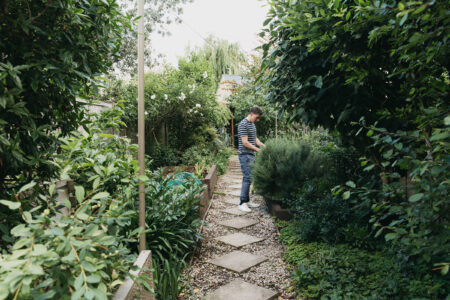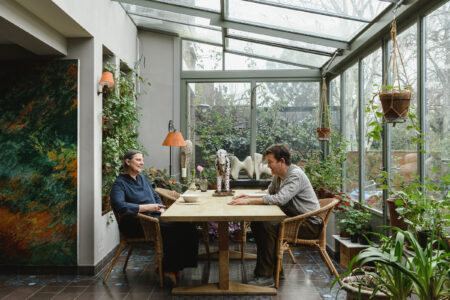How Joseph Denison Carey made a home for hosting supper clubs in Shoreditch, east London

Words Billie Brand
Photography Ellen Christina Hancock
Production Harry Cave
Joseph Dension Carey is happiest when hosting. The 24-year-old chef and TV personality (you might have caught him cooking live on ITV’s This Morning) founded The Bread and Butter Supper Club, which he currently runs from his home in Shoreditch, east London, in 2018 – its name a homage to deliciously simple food. “I might not have my own restaurant but I have this place where people can come and eat,” he says. “The supper club has given me creative autonomy and it’s a great way to practice.” There’s little evidence he needs it, however. Joseph knows precisely how to perfect a dinner-party menu and, having trained in the Italian region of Parma, is something of a pro when it comes to pasta. On the day of our visit, for example, he whips up a tasty plate of tagliatelle with cherry tomatoes and lemon. The secret, he says, lies in liberally salting boiling water.
As a budding chef, Joseph earned his stripes assisting Laura Jackson and Alice Levine at their supper club, before working under Gabriel Waterhouse, who turned his own – The Waterhouse Project – into a restaurant of the same name. “The first shift I did with Gabe was one of the last dinners he did in his flat,” Joseph says. “It’s been very inspiring to watch him graduate to an incredible space, given that what I want to do isn’t dissimilar.” Right now, though, he’s excited to get back in a professional kitchen (he previously worked in Pidgin) and is joining the team at Caravel as chef de partie, a job he’ll do alongside The Bread and Butter Supper Club. Here, we join Joseph on a trip to his local grocery to get the ingredients for dinner (which you can find the recipe for below) as he shares his hot takes on the art of hosting.




Joe: “This kitchen’s design works for hosting my supper club. Whenever I look for a place to live, the question I ask myself is: “Can I run a supper club from the kitchen?”. The Bread and Butter Supper Club genuinely fills me with so much joy and I love that this space can accommodate it. What I like about this kitchen and dining room is that it feels open – I can cook separately but experience the party too. I can hear what’s going on round the table – the sound of music, laughing and conversation. I love having people over for dinner. As someone who grew up without siblings and lives alone, I really enjoy filling my space with people and life.
“The kitchen itself is small – there’s only one bench, with the sink on the left and the hob on the right. It’s actually reminiscent of a section in a professional kitchen. When I was working at Pidgin a few years ago, I had to work in a very tight space like this – and I have set this one up in a similar way. I’ve managed to make the most of a modest space. That said, when I picture the perfect kitchen, I do think of a big open space with an island in the middle. I would love a professional set-up with really good hardware.
“My most cherished kitchen tools are my chef’s knife, Microplane grater and pasta machine. My chef’s knife is my number one. It was a gift from my family, who all chipped in to buy it for me for my 18th birthday. It’s a santoku knife from Shun. I’ve had it for six years now and it’s still as sharp as when I got it – I look after it like it’s a baby. I use it every day and for everything – whether I’m cooking for a supper club or just feeding myself. I’d also feel the loss of the Microplane. I use it to grate parmesan for pasta and risotto, as well as dark chocolate for tiramisu. And I love my pasta machine.


“The cookbooks I refer to the most are Polpo: A Venetian Cookbook (Of Sorts) by Norman Russell; The Book of St John by Fergus Henderson and Trevor Gulliver; and On Food and Cooking by Harold McGee.
Polpo is a beautiful book. It’s a constant source of inspiration and I love it for its traditional Italian vibe. The recipes are very simple and let the ingredients shine. I went to culinary school in Italy and it reminds me of the things that I learned there. St John represents a style of cooking I really like – just using ingredients well and serving them simply. It’s full of ‘home-cooked’ dishes – braised pork with lentils on the side, for instance. On Food and Cooking, meanwhile, is the best food book ever. It’s not really a cookbook; it’s more scientific. There is so much information in it. It’s incredible.
“My approach to home cooking is very basic. I make very simple things, like chicken and rice. When I’m home, I also like developing recipes. I usually begin by flicking through my cookbooks for ideas and then I just see where they take me. One of my most recent examples is ravioli with mascarpone, ricotta and nutmeg. I start off with the most basic version of it I can make – in this case, the sauce was just butter and sage, and the filling was cheese and nutmeg. Then I ask myself: “How can I build on it? How can I make the butter and sage more interesting?”. Then I just build and build on the ingredients and hopefully, after five or six tries, I’ll land on something that I feel is going to be good enough to serve to others.
“My earliest memories of home cooking, however, include the food that my Caribbean nanny – that’s my dad’s mum – would make. She’s from St Kitts and would always make salt-fish stew with tomatoes and red peppers, which she’d serve with rice and peas and steamed yam. It was always the same thing but it was a meal that I never got anywhere else. My mum is white and when I was younger, a lot of the friends I had were too. It meant that there’s a huge part of my cultural heritage I didn’t get to experience much. When I did go to see my nanny and granddad, I loved the food. It was so tasty.

“A classic weekday meal here is very simple. I make a lot of sushi rice, which I’ll have with a sauce made from peanut butter and crispy chilli. But it’s just fuel for me – I don’t like cooking for myself. I like the adventure of cooking for other people. That’s the drive. If I am though, I will make pasta. Having trained in Italy, I can make a sauce really well without paying too much attention to it, because I’ve done it so many times.
“At the weekend I like to prepare for the next supper club. I always do four courses, so I have to think about things that I can cook and serve by myself. Seasonality is very important, but I also play to my strengths. I do a lot of pasta and I really like the format of traditional Italian meals, in which you have the starter, the primi, which is often pasta or rice, your secondi (meat or fish), and dessert.
“I don’t go out to eat as much as I would love to. I feel like I should do it more, as dining at restaurants is always a good experience. It’s great to see what’s happening out there and to get ideas for my own recipes.
“My favourite memories here are of my most recent supper club. The guests included my mum and stepdad, as well as some very close family friends. I prepped the dessert in advance so that once I had cooked the main, I could come and sit down with everyone, have a couple of glasses of prosecco and a nice chat. I suppose that one meant the most because it was with family. I’ve reconnected with old friends through the club too – someone I went to primary school with came to my first one and brought her mates along, for example. They’ve all been really special. People come, they eat, relax, talk, laugh and get a little drunk. It’s nice knowing that I’ve created that space for people.”


Joseph’s recipe for pasta with cherry tomatoes and lemon
Serves two
Olive oil
2 large handfuls of cherry tomatoes, halved
2 cloves of garlic, grated or finely chopped
2 portions of dry tagliatelle (or any dry pasta)
1 handful of chopped parsley
1 handful of grated parmesan
2 egg yolks
1 handful of grated parmesan
Salt
Black pepper
1 squeeze of fresh lemon
In a pan, olive oil on a medium heat and cook the tomatoes until they blister. Break them apart with a wooden spoon so their juices are released into the pan. Add the garlic and allow everything to simmer.
Meanwhile, drop your dry pasta into salted boiling water. In the time it takes to cook the pasta, your sauce should thicken and the garlic cook.
Once cooked, drain the pasta, saving a cup of the starchy water. Turn off the heat that’s cooking the sauce to stop the pan from getting too hot and scrambling the egg yolks.
Add your pasta to the tomato sauce with the parsley, parmesan and egg yolks and mix together.
Season with salt, pepper and a small squeeze of lemon. Add some pasta water to the sauce if it seems too thick. The residual heat from the pan and the pasta should thicken the egg yolk, but if your sauce seems too runny then turn the heat back on low and allow it to thicken while you stir it.
Divide between two bowls and serve with some more parmesan grated over the top.









